-
 Bitcoin
Bitcoin $117700
-0.03% -
 Ethereum
Ethereum $3805
0.49% -
 XRP
XRP $3.098
-1.00% -
 Tether USDt
Tether USDt $1.000
0.03% -
 BNB
BNB $792.8
-1.72% -
 Solana
Solana $177.9
-1.95% -
 USDC
USDC $1.000
0.02% -
 Dogecoin
Dogecoin $0.2202
-1.55% -
 TRON
TRON $0.3278
-2.92% -
 Cardano
Cardano $0.7641
-2.43% -
 Hyperliquid
Hyperliquid $42.21
-2.68% -
 Sui
Sui $3.758
-1.58% -
 Stellar
Stellar $0.4080
-3.21% -
 Chainlink
Chainlink $17.75
-0.33% -
 Bitcoin Cash
Bitcoin Cash $591.8
4.96% -
 Hedera
Hedera $0.2561
-3.09% -
 Avalanche
Avalanche $23.34
-4.24% -
 Litecoin
Litecoin $110.7
1.96% -
 UNUS SED LEO
UNUS SED LEO $8.956
-0.01% -
 Toncoin
Toncoin $3.410
0.79% -
 Ethena USDe
Ethena USDe $1.001
0.03% -
 Shiba Inu
Shiba Inu $0.00001288
-1.82% -
 Uniswap
Uniswap $10.07
-2.06% -
 Polkadot
Polkadot $3.807
-2.27% -
 Monero
Monero $308.2
-2.15% -
 Dai
Dai $1.000
0.03% -
 Bitget Token
Bitget Token $4.521
-0.30% -
 Pepe
Pepe $0.00001134
-1.52% -
 Cronos
Cronos $0.1457
0.65% -
 Aave
Aave $274.9
-2.47%
How to judge the rebound buying point of daily KDJ oversold + 60-minute Yang Baoyin?
When the daily KDJ shows J below 20 and K crosses above D, watch for a 60-minute Yang Baoyin with high volume to confirm a high-probability rebound entry.
Jul 30, 2025 at 01:08 pm
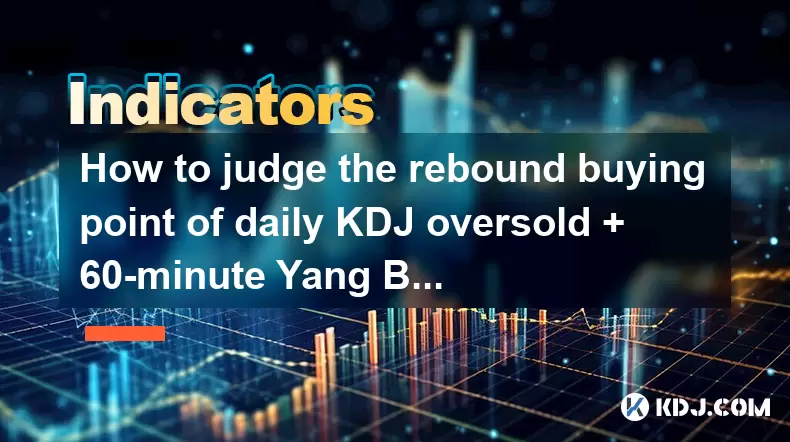
Understanding the KDJ Indicator in Daily Timeframe
The KDJ indicator is a momentum oscillator widely used in cryptocurrency trading to identify overbought and oversold conditions. It consists of three lines: K line, D line, and J line. The K line responds quickly to price changes, the D line is a smoothed version of the K line, and the J line reflects the deviation between K and D. When the J line drops below 20, the market is typically considered oversold, signaling a potential reversal. In daily charts, this condition suggests that selling pressure has exhausted, and a rebound may occur. Traders monitor the crossing of K and D lines from below 20 upward as a confirmation signal. It’s critical to ensure that the K line crosses above the D line within the oversold zone, which increases the reliability of the buy signal.
Interpreting 60-Minute Yang Baoyin Pattern
The Yang Baoyin pattern, originating from Japanese candlestick analysis, refers to a bullish engulfing pattern that forms over two consecutive candlesticks. In the 60-minute timeframe, this pattern appears when a large green (bullish) candle completely engulfs the body of the previous red (bearish) candle. This indicates a shift in market sentiment from bearish to bullish. The larger the body of the green candle relative to the prior red candle, the stronger the reversal signal. For this pattern to be valid, the volume during the formation of the green candle should be significantly higher than the previous period, confirming strong buying interest. Traders should look for this pattern to appear after a sustained downtrend and in alignment with other indicators such as the daily KDJ oversold signal.
Combining Daily KDJ Oversold with 60-Minute Yang Baoyin
To identify a high-probability rebound buying point, both conditions must align:
- The daily KDJ must show an oversold signal, specifically the J line below 20 and the K line crossing above the D line.
- A 60-minute Yang Baoyin pattern must form shortly after the oversold signal, preferably within the same trading day or the next.
When both signals occur together, they reinforce each other. The daily KDJ indicates exhaustion of downward momentum, while the 60-minute Yang Baoyin shows active buying pressure at a shorter timeframe. This confluence increases the likelihood of a sustainable price rebound. Traders should wait for the Yang Baoyin candle to close fully before acting, ensuring the pattern is confirmed and not a false breakout.
Step-by-Step Entry Strategy
To execute a precise entry based on this setup:
- Monitor the daily KDJ indicator and confirm the J line is below 20.
- Watch for the K line to cross above the D line in the daily chart, indicating a potential turnaround.
- Switch to the 60-minute chart and wait for a bearish candle followed by a bullish candle that completely engulfs the prior candle’s body.
- Ensure the volume on the bullish candle is noticeably higher than the previous candle.
- Place a buy order at the close of the Yang Baoyin candle or at the opening of the next candle.
- Set a stop-loss just below the low of the Yang Baoyin pattern to manage downside risk.
- Confirm the trade setup with support levels or trendline breaks if available.
This method minimizes false signals by requiring confirmation across multiple timeframes and technical elements.
Filtering False Signals and Risk Management
Not every KDJ oversold condition leads to a rebound, and not every Yang Baoyin pattern results in a sustained uptrend. To reduce risk:
- Avoid trading if the overall market trend is strongly bearish on higher timeframes like weekly charts.
- Check for major resistance levels above the current price that could cap upward movement.
- Use volume analysis to confirm participation; low-volume engulfing patterns are less reliable.
- Consider macroeconomic or project-specific news that could influence price independently of technicals.
- Apply position sizing so that no single trade risks more than 1–2% of total capital.
- Use trailing stop-loss after entry to protect profits if the rebound continues.
These filters help distinguish between genuine reversal opportunities and temporary bounces in a downtrend.
Practical Example Using a Cryptocurrency Chart
Suppose Bitcoin (BTC) has been declining for several days. On the daily chart:
- The KDJ J line drops to 15, entering oversold territory.
- The K line (blue) crosses above the D line (red) at the 18 level, signaling a potential reversal.
Switching to the 60-minute chart:
- A red candle forms with a closing price of $26,000.
- The next candle opens lower but reverses strongly, closing at $26,800 with a long green body.
- This green candle fully engulfs the previous red candle’s body.
- Volume increases by over 40% compared to the prior hour.
A trader would:
- Confirm both the daily KDJ crossover and the 60-minute Yang Baoyin.
- Enter a long position at $26,800 or the next candle’s open.
- Set a stop-loss at $25,900, just below the Yang Baoyin low.
- Monitor for continuation candles to validate the rebound.
Frequently Asked Questions
What if the Yang Baoyin pattern appears but the daily KDJ hasn’t crossed yet?
Wait for the daily K line to cross above the D line before acting. Premature entries based on the 60-minute pattern alone carry higher risk, especially if the broader momentum remains bearish.
Can this strategy be applied to altcoins?
Yes, but ensure the altcoin has sufficient trading volume and liquidity. Low-volume coins may generate false KDJ signals or unreliable candlestick patterns due to market manipulation.
How long should I hold the position after entering?
Hold until profit targets are reached or a clear reversal signal appears, such as a bearish engulfing pattern or KDJ entering overbought (J line above 80). Do not hold indefinitely without a defined exit plan.
Does this strategy work during major bear markets?
It can produce signals, but success rate decreases in strong downtrends. Always assess the higher timeframe trend; in prolonged bear markets, oversold conditions can persist, leading to multiple failed rebounds.
Disclaimer:info@kdj.com
The information provided is not trading advice. kdj.com does not assume any responsibility for any investments made based on the information provided in this article. Cryptocurrencies are highly volatile and it is highly recommended that you invest with caution after thorough research!
If you believe that the content used on this website infringes your copyright, please contact us immediately (info@kdj.com) and we will delete it promptly.
- LYNO Token Presale: AI Arbitrage Revolution in DeFi
- 2025-07-31 05:11:11
- Pepecoin Successors: Can These Cryptocurrencies Make You a Millionaire?
- 2025-07-31 05:50:12
- AML Bitcoin Fraud: Cracking Down on Crypto Crime in the Big Apple and Beyond
- 2025-07-31 04:33:53
- Cardano (ADA) in 2025: Navigating Crypto's Future
- 2025-07-31 03:52:07
- Solana Meme Coin Price Prediction: Will the Frog Outleap the Dog?
- 2025-07-31 03:52:07
- Bitcoin's Bullish Outlook: CryptoQuant's Insights on Futures Market Cooling
- 2025-07-31 03:59:10
Related knowledge

How to identify sell signals with the AVL indicator?
Jul 31,2025 at 07:09am
Understanding the AVL Indicator and Its Core ComponentsThe AVL indicator, also known as the Accumulation Volume Line, is a volume-based technical anal...

How does the VWAP line help in identifying overbought and oversold market conditions?
Jul 31,2025 at 05:19am
Understanding the VWAP Line and Its Role in Technical AnalysisThe Volume Weighted Average Price (VWAP) is a critical tool used by traders within the c...
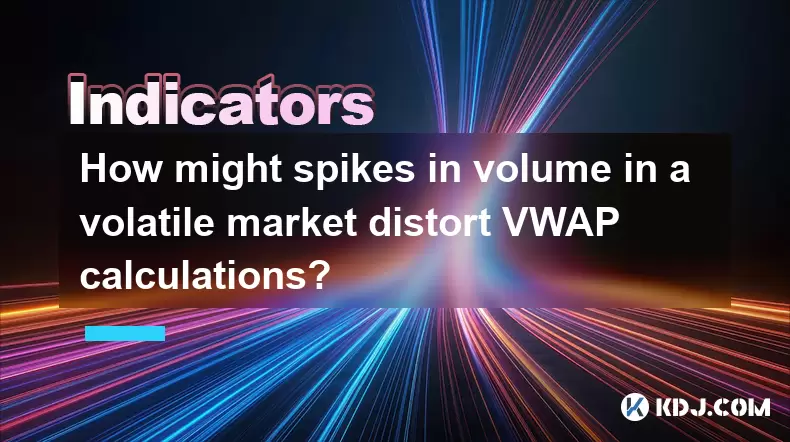
How might spikes in volume in a volatile market distort VWAP calculations?
Jul 31,2025 at 07:40am
Understanding VWAP and Its Core ComponentsVWAP, or Volume-Weighted Average Price, is a trading benchmark that gives the average price a cryptocurrency...
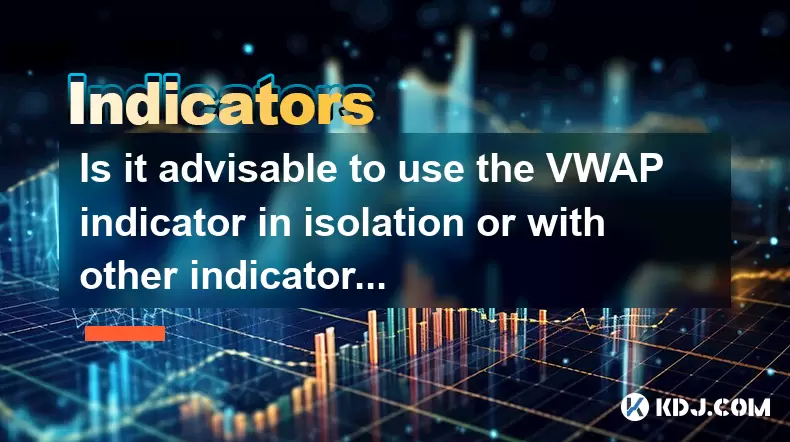
Is it advisable to use the VWAP indicator in isolation or with other indicators?
Jul 31,2025 at 06:48am
Understanding the VWAP Indicator and Its Core FunctionalityThe Volume Weighted Average Price (VWAP) is a widely used technical analysis tool in the cr...
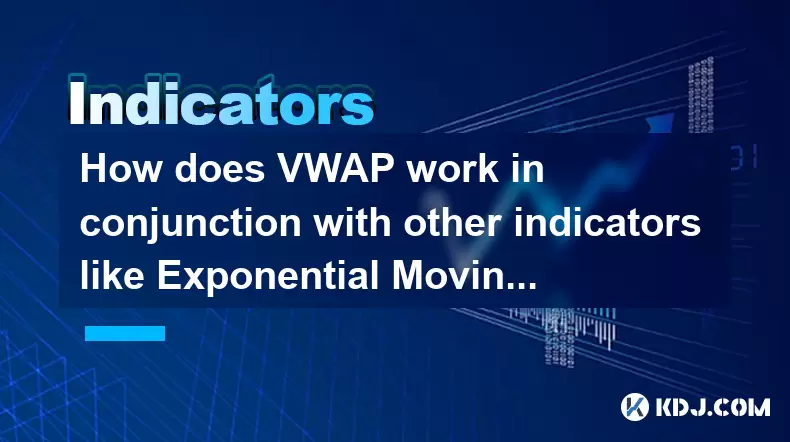
How does VWAP work in conjunction with other indicators like Exponential Moving Averages (EMAs)?
Jul 31,2025 at 04:38am
Understanding VWAP and Its Role in Crypto TradingThe Volume Weighted Average Price (VWAP) is a critical analytical tool in cryptocurrency trading, par...
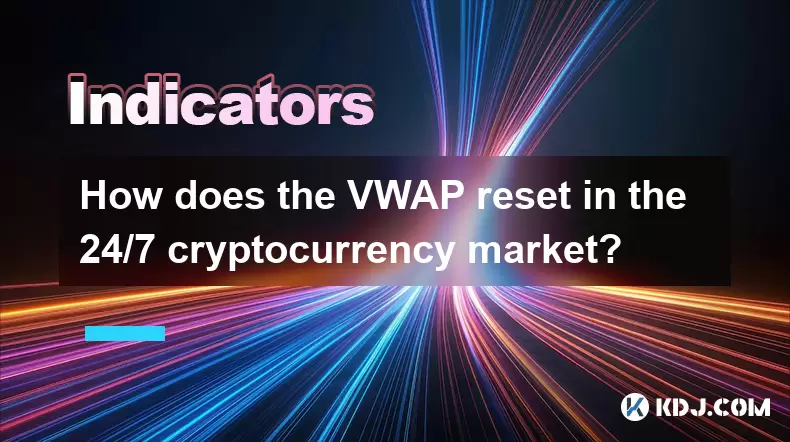
How does the VWAP reset in the 24/7 cryptocurrency market?
Jul 31,2025 at 06:38am
Understanding VWAP in Cryptocurrency MarketsThe Volume Weighted Average Price (VWAP) is a trading benchmark that calculates the average price of an as...

How to identify sell signals with the AVL indicator?
Jul 31,2025 at 07:09am
Understanding the AVL Indicator and Its Core ComponentsThe AVL indicator, also known as the Accumulation Volume Line, is a volume-based technical anal...

How does the VWAP line help in identifying overbought and oversold market conditions?
Jul 31,2025 at 05:19am
Understanding the VWAP Line and Its Role in Technical AnalysisThe Volume Weighted Average Price (VWAP) is a critical tool used by traders within the c...

How might spikes in volume in a volatile market distort VWAP calculations?
Jul 31,2025 at 07:40am
Understanding VWAP and Its Core ComponentsVWAP, or Volume-Weighted Average Price, is a trading benchmark that gives the average price a cryptocurrency...

Is it advisable to use the VWAP indicator in isolation or with other indicators?
Jul 31,2025 at 06:48am
Understanding the VWAP Indicator and Its Core FunctionalityThe Volume Weighted Average Price (VWAP) is a widely used technical analysis tool in the cr...

How does VWAP work in conjunction with other indicators like Exponential Moving Averages (EMAs)?
Jul 31,2025 at 04:38am
Understanding VWAP and Its Role in Crypto TradingThe Volume Weighted Average Price (VWAP) is a critical analytical tool in cryptocurrency trading, par...

How does the VWAP reset in the 24/7 cryptocurrency market?
Jul 31,2025 at 06:38am
Understanding VWAP in Cryptocurrency MarketsThe Volume Weighted Average Price (VWAP) is a trading benchmark that calculates the average price of an as...
See all articles

























































































